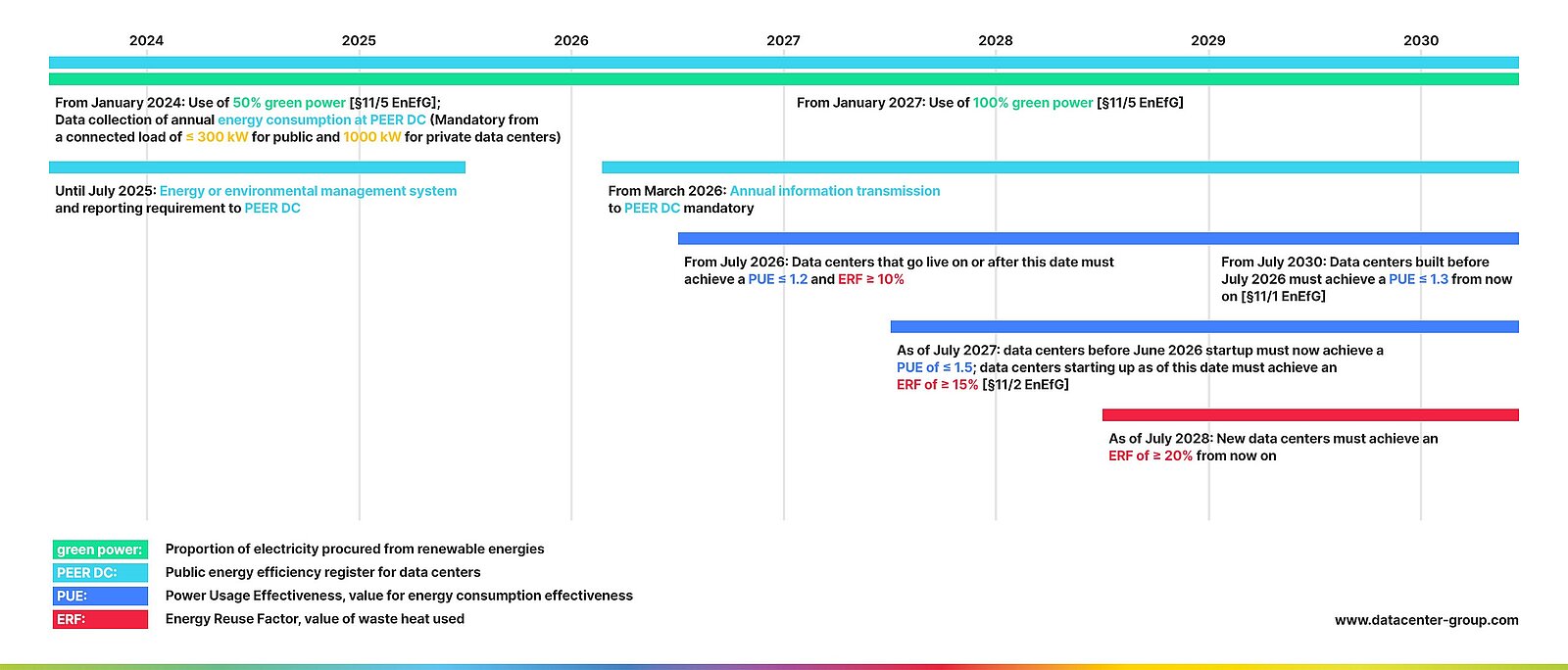Are there now clear guidelines? After the draft bill for the Energy Performance Act was not passed on July 7, 2023, the bill was discussed and passed on September 21, 2023 after the parliamentary summer break with some delay. The coalition parties SPD, Bündnis 90 / Die Grünen and the FDP voted in favor of the law, while the opposition parties voted against it. On October 20, the law passed the Federal Council as the final step.
What do data center planners, builders and operators need to bear in mind with regard to the new law? We have summarized the most important points:
What PUE must be complied with?
In the section "Energy efficiency of data centers", the draft stipulates that data centers must not exceed a certain value of energy consumption effectiveness or Power Usage Effectiveness (PUE). This is staggered according to the year of commissioning of the data centers:
Operation before July 1, 2026: From July 1, 2027 PUE ≤ 1.5 | From July 1, 2030 PUE ≤ 1.3
Operation from July 1, 2026: PUE ≤ 1.2
Waste heat utilization and avoidance
An obligation to mutually disclose load assumptions and customers (i.e. energy suppliers) has been agreed. However, how this is to be implemented is not regulated. The obligation to use waste heat does not apply if the heat network operator does not respond to the request for 6 months or no customer can be found. In this case, the data center operator must prove that it provides the necessary capacities, supplies a suitable infrastructure and that an investment plan and financial framework conditions have been regulated or that the customer does not accept the offer despite it being in line with the market.
The proportion of reused energy (ERF - Energy Reuse Factor) must be
at least 10% from 1.7.2026,
15% from 1.7. 2027 and
20% from 1.7.2028.
Establishment of energy or environmental management systems
From 01.01.2026, the establishment of an energy or environmental management system is mandatory
from 1 MW connected load for private data centers and
from 300 kW for public sector data centers
Register for data centers
In future, all important data from the data center must be entered into a database for data centers (PEER-DC). The purpose of this database is to monitor, control, improve and document environmental issues relating to data centers. A distinction is made between public information and protected data. The aim here is to strike a balance between data protection due to security-related concerns and a register to simplify the comparison of data centers. Annual energy consumption must be reported to PEER-DC from 2024. From mid-2025, reporting to PEER-DC and the establishment of an energy or environmental management system will be mandatory. In March 2026, a mandatory annual submission of information to PEER-DC will come into force.
These laws apply to data centers with a connected load ≥ 300 kW for public data centers and ≥ 1000 kW for private data centers.
Purchasing electricity from renewable energy sources
Data center operators are obliged to purchase 50% of their electricity from renewable energy sources from 2024 and 100% from 2027. However, the guarantees of origin (HKN) - i.e. proof of the region from which the electricity is sourced - do not have to originate from Germany or the EU.
When does what apply to whom? Our timeline shows which dates and values need to be taken into account:

Conclusion and classification - possible gaps in the law
The draft law regulates and regulates many important things, but still shows gaps in relation to the actual focus on "sustainability". For example, there is a grace period for existing data centers. A date could be specified for an upgrade to ensure that, for example, certain PUE values are achieved and operation becomes more efficient. The values are fixed for new systems, which means that more money has to be invested in the technical infrastructure.
The creation of a sustainable IT strategy is completely missing from the draft legislation - although this is where the greatest potential for energy savings exists. An IT strategy is the origin and foundation of every data center.
The concept of PUE also appears problematic. Generally speaking, this key figure is an important indicator for sustainable data centers, but it does not represent the entire picture, as the value depends on various individual factors. For example, the PUE can even deteriorate if the data center becomes more energy efficient.
WUE up, PUE down - Evaporative cooling can significantly reduce the PUE value of a data center, but leads to higher water consumption. The WUE (Water Usage Effectiveness) is not regulated in the draft legislation. PUE values are often used to compare data centers, but the basic requirements are not the same. On the one hand, hyperscale data centers can achieve a lower PUE than colocation data centers, and on the other hand, the PUE depends on the outside temperatures. It is therefore relevant whether a data center is located in the north or south of Germany. Setting the PUE value at 1.2 or lower for new data centers (from 2026) also seems too ambitious. According to a study by the Bitkom Institute, the average value for all data centers in operation was 1.55.
With regard to a register for data centers, PEER-DC used a functioning infrastructure and thus saved resources for setting up a new register. However, the laws on data collection and information transfer only apply to public data centers with a connected load of 300 kilowatts or more. This is a value that very few companies achieve and therefore does not appear in this register.
The fact that the electricity does not have to come from Germany or other EU countries also makes it easier to purchase, but counteracts the idea of sustainability with regard to sustainable electricity.
In conclusion, it should be noted that the approaches contained in the draft legislation are important and sensible. However, it does not appear to be fully developed, as various points are formulated in a very unspecific manner, meaning that loopholes can be exploited that severely weaken the law. Clarification seems to be the right keyword here.
Further information on the Energy Efficiency Act and how we are working sustainably on the issues of the future can be found here.
Title Picture: © Andrii Yalanskyi / #303849484 / stock.adobe.com (Standard licence)



